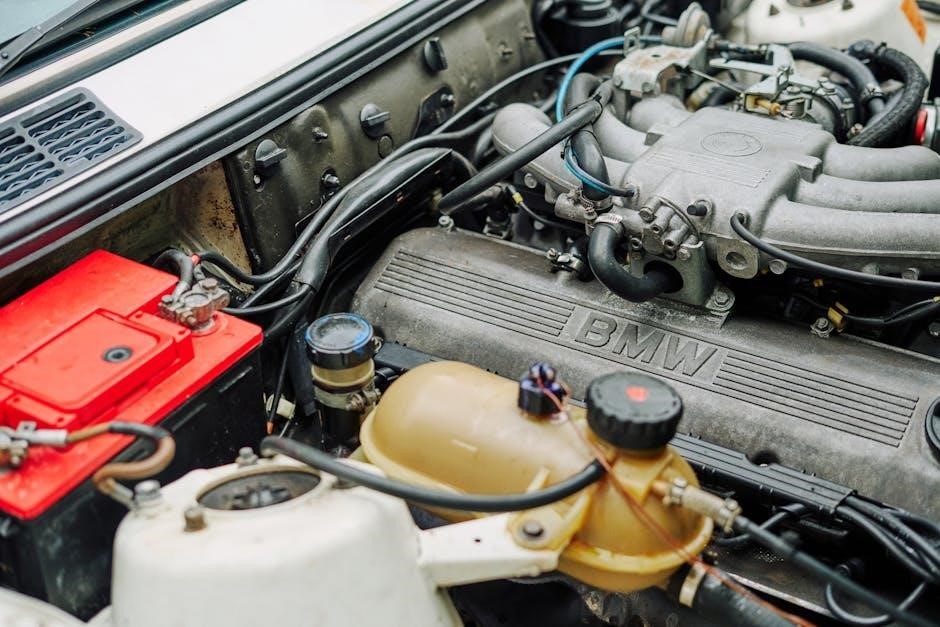The required high school reading list is a cornerstone of education, fostering critical thinking, empathy, and intellectual growth through timeless classics and contemporary works.
Overview of the Importance of Reading in High School
Reading is a foundational skill that plays a crucial role in high school education, fostering academic success and personal growth. It enhances comprehension, critical thinking, and analytical abilities, preparing students for college and beyond. Through exposure to diverse texts, students gain empathy, cultural awareness, and a deeper understanding of complex themes. Reading also improves vocabulary, fluency, and communication skills, essential for lifelong learning. High school reading lists are curated to challenge students, spark curiosity, and cultivate a love for literature. By engaging with both classic and modern works, students develop the ability to interpret and connect with ideas, fostering intellectual and emotional maturity. This skill set is vital for navigating an increasingly complex world.

Why a Structured Reading List is Essential for Students
A structured reading list provides students with a balanced and diverse exposure to literature, ensuring they encounter a wide range of genres, authors, and perspectives. This intentional selection helps bridge gaps in knowledge and fosters a cohesive learning experience. By organizing texts by difficulty and thematic relevance, educators guide students through progressively challenging material, building both skills and confidence. A well-crafted list also aligns with academic goals, preparing students for standardized tests and future studies. Moreover, it ensures equity, giving all students access to essential works that might otherwise be overlooked. This approach creates a shared cultural and intellectual foundation, enriching students’ educational journeys and beyond.
How the Reading List Prepares Students for College and Beyond
The high school reading list plays a pivotal role in preparing students for the academic demands of college and their future careers. By exposing students to complex texts, the list enhances critical thinking, analytical skills, and the ability to articulate ideas effectively. These works often mirror the challenging literature encountered in higher education, ensuring students are well-equipped to tackle college-level reading and writing. Additionally, the list fosters a deeper understanding of diverse perspectives, cultural contexts, and historical narratives, which are essential for informed engagement in an increasingly global society. This foundational preparation not only supports academic success but also cultivates lifelong learning habits and intellectual curiosity.

Classics in the High School Reading List
Classics like Shakespeare, Faulkner, and Orwell are essential, shaping critical thinking and cultural understanding through timeless themes and complex narratives that remain relevant across generations.
Timeless Novels Every Student Should Read
Timeless novels like To Kill a Mockingbird, 1984, and Pride and Prejudice are cornerstone texts in high school curriculums. These works explore universal themes of justice, morality, and humanity, resonating across generations. Harper Lee’s exploration of racial injustice, Orwell’s depiction of totalitarianism, and Austen’s insight into societal dynamics provide students with a deeper understanding of the world. These novels are chosen for their ability to provoke critical thinking, emotional connection, and empathy. They often serve as a foundation for discussions on ethics, identity, and societal structures. Reading such works prepares students to engage with complex ideas, fostering a lifelong appreciation for literature and its role in shaping perspectives. Their inclusion in reading lists ensures students encounter diverse voices and perspectives, enriching their educational journey.
Shakespeare’s Plays: A Cornerstone of High School Curriculum
Shakespeare’s plays are a fundamental part of high school reading lists, offering profound insights into human nature, morality, and societal dynamics. Works like Romeo and Juliet, Hamlet, and Macbeth explore universal themes of love, ambition, and justice. These plays challenge students to grapple with complex emotions and ethical dilemmas, fostering critical thinking and empathy. Shakespeare’s language, rich in imagery and metaphor, enhances vocabulary and fosters a deeper appreciation for literary artistry. Engaging with these texts prepares students for advanced literary analysis and helps them understand the historical and cultural contexts that shape human experiences. The inclusion of Shakespeare’s works ensures students develop a strong foundation in classical literature, essential for both academic and personal growth.
19th and 20th Century Authors: Their Contributions to the Reading List
Authors from the 19th and 20th centuries significantly enrich high school reading lists with diverse perspectives and literary styles. Works by Dickens, Faulkner, Orwell, and other influential writers introduce students to themes of social justice, human struggle, and moral complexity. Novels like A Tale of Two Cities and 1984 highlight historical contexts and societal critiques, fostering analytical thinking. These texts also expose students to varied narrative techniques, from Dickens’s vivid characterizations to Faulkner’s non-linear storytelling. By engaging with these works, students gain a deeper understanding of literary evolution and the cultural shifts that shaped modern literature. These authors’ contributions ensure a well-rounded curriculum that challenges students to think critically about the world around them.
Poetry and Its Role in Developing Critical Thinking Skills
Poetry plays a vital role in high school reading lists by fostering critical thinking and analytical skills. Through its concise and layered language, poetry challenges students to interpret themes, imagery, and emotions. Works by poets like William Carlos Williams and others encourage students to explore metaphor, simile, and other literary devices, enhancing their understanding of nuanced communication. Poetry also cultivates emotional intelligence, as it often reflects universal human experiences. By engaging with diverse poetic styles and voices, students develop the ability to analyze complex ideas and express their interpretations clearly. This skill is essential for academic success and lifelong learning, making poetry a cornerstone of the high school curriculum.

Modern Literature in the High School Curriculum
Modern literature engages students with contemporary themes, diverse voices, and relatable stories, fostering deeper connections to their lives and broadening cultural understanding through innovative narratives.
Contemporary Novels That Resonate with Teenagers
Contemporary novels offer relatable stories that reflect modern teenage experiences, tackling issues like identity, social justice, and coming-of-age challenges. Books such as The Hate U Give by Angie Thomas and The Perks of Being a Wallflower by Stephen Chbosky delve into themes of race, friendship, and self-discovery, resonating deeply with young readers. These stories often mirror real-world struggles, encouraging empathy and understanding. By incorporating diverse voices and current societal concerns, these novels create a connection between the curriculum and students’ lives, fostering meaningful discussions and personal growth. They also help students develop critical thinking skills by exploring complex, modern issues through engaging narratives.
Diverse Perspectives: Books Representing Different Cultures and Identities
Books representing diverse cultures and identities are essential for fostering empathy and understanding in high school students. Novels like The Kite Runner by Khaled Hosseini and Between the World and Me by Ta-Nehisi Coates provide vivid portrayals of experiences shaped by cultural heritage and societal challenges. These stories encourage students to explore perspectives beyond their own, promoting inclusivity and appreciation for global diversity. By incorporating works from authors of various backgrounds, reading lists help students engage with themes such as identity, belonging, and social justice. This exposure enriches their worldview and prepares them to navigate an increasingly interconnected society with sensitivity and awareness.
Genre-Specific Reads: From Science Fiction to Historical Fiction
High school reading lists often include genre-specific novels to broaden students’ literary exposure. Science fiction works like 1984 by George Orwell and The Giver by Lois Lowry explore futuristic themes, encouraging critical thinking about societal structures. Historical fiction, such as To Kill a Mockingbird by Harper Lee, immerses students in past eras, fostering empathy and historical understanding. Dystopian novels like Fahrenheit 451 by Ray Bradbury prompt reflections on censorship and freedom. These diverse genres help students analyze complex themes and develop a deeper appreciation for literature. By engaging with varied storytelling styles, students enhance their ability to interpret and connect with texts across different contexts and perspectives.
Award-Winning Books That Should Be on Every Reading List
Award-winning books are integral to high school reading lists, offering students compelling narratives and thought-provoking themes. Titles like The Kite Runner by Khaled Hosseini, a recipient of the Quill Award, and The Hate U Give by Angie Thomas, which won the Michael L. Printz Award, provide diverse perspectives. These books are chosen for their literary merit and ability to resonate with teenagers. They often address contemporary issues, such as race, identity, and social justice, fostering empathy and critical thinking. Including award-winning literature ensures students engage with works recognized for their excellence, enriching their educational experience and broadening their understanding of the world.

Building Reading Skills Through the Curriculum
Building reading skills involves fostering comprehension, fluency, and vocabulary through structured strategies and diverse texts, enabling students to engage deeply with complex materials and develop critical thinking.
Developing Reading Comprehension: Key Strategies
Developing reading comprehension involves active reading techniques, such as summarization, question generation, and close analysis of texts. Students learn to identify main ideas, make inferences, and analyze themes. Vocabulary expansion and contextual understanding are emphasized to enhance fluency. Encouraging discussions in class fosters deeper engagement and critical thinking. Strategies like previewing content, setting purposes for reading, and reflecting afterward also improve retention. Providing structured study guides and practice exercises helps reinforce these skills. Additionally, incorporating diverse texts exposes students to varied perspectives, enriching their comprehension abilities. These methods collectively prepare students for advanced reading challenges and lifelong learning, ensuring they can interpret and apply complex ideas effectively.
Fluency and Vocabulary Expansion: Essential Components
Fluency and vocabulary expansion are foundational skills that enhance reading proficiency. Fluency involves reading with accuracy, speed, and expression, allowing students to focus on comprehension. Vocabulary expansion introduces students to new words, phrases, and meanings, enriching their understanding of texts. These skills are cultivated through guided reading, independent practice, and interactive activities. Exposure to challenging texts from the high school reading list helps students encounter diverse vocabulary in context. Educators emphasize repetition and discussion to reinforce word meanings and promote confident reading. By mastering fluency and expanding vocabulary, students gain the tools to tackle complex literature and communicate effectively in academic and real-world settings, preparing them for future success.
Encouraging Independent Reading for Pleasure and Growth
Independent reading fosters a lifelong love for literature, allowing students to explore diverse genres, themes, and perspectives at their own pace. Educators promote this by creating a supportive environment where students can choose books that resonate with their interests. Access to varied and engaging texts, including both classic and modern works, is essential. Libraries and reading lists often highlight titles that cater to different tastes and reading levels. Encouraging discussion through book clubs or informal conversations further enriches the experience. By prioritizing pleasure and personal growth, independent reading helps students develop a deeper appreciation for literature and enhances their overall academic and personal development, preparing them for a lifetime of learning and exploration.
Teaching Critical Thinking Through Challenging Texts
Challenging texts are essential for fostering critical thinking in high school students, as they require deeper analysis and interpretation. These works often explore complex themes, moral dilemmas, and nuanced characters, prompting students to question and evaluate ideas. Educators use discussion-based methods, such as Socratic seminars, to guide students in unpacking difficult passages. Assignments like analytical essays and debates further encourage students to synthesize information and articulate their perspectives. By engaging with texts that push their understanding, students develop the ability to think independently, evaluate evidence, and form well-supported arguments. This skill is crucial for academic success and lifelong learning, preparing students to navigate complex ideas in college and beyond.

Grade-Specific Reading Recommendations
Grade-specific reading lists tailor selections to students’ developmental stages, ensuring texts align with their growing comprehension and thematic understanding, from foundational freshman works to complex senior novels.
Freshman Year: Foundational Books for New High School Students
Freshman year reading focuses on foundational texts that introduce students to essential themes, literary devices, and critical thinking. Classics like To Kill a Mockingbird and The Giver explore moral dilemmas and societal issues, fostering empathy and understanding. Shakespeare’s Romeo and Juliet is often included to familiarize students with timeless drama and poetic language. These works are chosen for their accessibility and relevance to early high school students, helping to build a strong literary base. They also encourage a love for reading and prepare students for more complex texts in later years. By engaging with these stories, freshmen develop vocabulary, comprehension, and analytical skills crucial for academic success and lifelong learning.
Sophomore Year: Expanding Horizons Through Reading
Sophomore year reading expands students’ literary horizons, introducing more complex themes and diverse perspectives. Works like The Crucible and 1984 delve into societal issues, morality, and political commentary, fostering deeper critical thinking. These texts challenge students to analyze conflicting viewpoints and historical contexts, enhancing their understanding of human experiences. Novels such as The Kite Runner and Into the Wild explore cultural and personal identity, encouraging empathy and global awareness. Poetry and short stories are also integrated to refine language skills and broaden interpretative abilities. By engaging with these works, sophomores develop a stronger appreciation for literature and prepare for the analytical demands of upper-level courses, building a solid foundation for future academic success and intellectual growth.
Junior Year: Preparing for Advanced Placement and College-Level Texts
Junior year reading focuses on advanced texts to prepare students for college-level work, emphasizing complex analysis and critical thinking. Novels like The Great Gatsby and Beloved explore themes of identity, morality, and societal structures, requiring deeper engagement. Plays such as Hamlet and Death of a Salesman challenge students to interpret dramatic techniques and universal themes. Additionally, exposure to philosophical works and historical documents enhances analytical skills, mirroring college curricula. This year also introduces research papers and seminars, fostering independent study habits and academic rigor, ensuring students are well-equipped for the demands of Advanced Placement courses and future collegiate studies, building a strong literary and academic foundation.

Senior Year: Culminating Reading Experiences
Senior year reading culminates in advanced, thought-provoking texts that synthesize previous skills, preparing students for lifelong learning. Works like Fahrenheit 451 and 1984 explore dystopian themes, encouraging reflection on society and ethics. Shakespearean plays such as Macbeth and Othello deepen understanding of human nature and conflict. Additionally, contemporary novels like The Kite Runner offer diverse perspectives, fostering empathy and global awareness. This year also includes capstone projects, where students analyze and present on major works, integrating critical thinking and communication skills. The senior reading list aims to inspire a love of reading and prepare students for the intellectual challenges of college and beyond, ensuring a smooth transition to higher education and personal growth.

Resources and Tools for Students and Educators
Study guides, online platforms, and librarian recommendations provide essential support, while book clubs and reading challenges foster a collaborative learning environment for students and educators alike;
Study Guides and Resources for Better Understanding
Study guides and educational resources play a vital role in helping students grasp complex texts from the required high school reading list; These materials often include summaries, analyses, and critical insights that break down challenging works. Online platforms like SparkNotes and CliffNotes provide accessible explanations, while interactive tools offer engaging ways to explore themes and characters. Many schools and educators recommend these resources to supplement classroom instruction, ensuring students can understand and appreciate the literature fully. Additionally, study guides often contain essay prompts and discussion questions, which are invaluable for preparing for exams and assignments. By leveraging these tools, students can deepen their comprehension and develop a richer connection to the texts they study.
Online Platforms and Apps to Enhance Reading Experiences
Online platforms and apps have revolutionized how students engage with required high school reading lists. Tools like Goodreads and SparkNotes offer detailed analyses, summaries, and study guides to aid comprehension. Apps such as Duolingo and Quizlet help expand vocabulary, while platforms like Scribd provide access to e-books and study materials. Interactive reading apps, such as ReadTheory, offer personalized reading exercises tailored to skill levels. These digital resources not only make learning more accessible but also foster a community of readers through forums and book clubs. By leveraging technology, students can enhance their reading experiences, deepen their understanding of texts, and develop a lifelong love for literature in a modern, engaging way.
Librarian and Teacher Recommendations for Engaging Reads
Librarians and teachers play a vital role in curating engaging reads for high school students; They often create diverse reading lists that reflect a variety of genres, cultures, and perspectives, ensuring there’s something for every student. Recommendations are typically based on popularity, educational value, and relevance to student interests. Tools like Goodreads and Study Guides help educators identify texts that align with curriculum goals. Many teachers also incorporate modern and classic literature to balance tradition with contemporary themes. By fostering a collaborative effort, librarians and teachers help students discover new authors and genres, making reading a more enjoyable and enriching experience. These recommendations often include interactive guides and reading apps to further support learning.

Reading Challenges and Book Clubs to Foster a Reading Community

Reading challenges and book clubs are effective tools for fostering a vibrant reading community in high schools. These initiatives encourage students to explore diverse genres, share perspectives, and develop a deeper appreciation for literature. Many schools organize reading challenges that align with the required reading list, offering incentives for participation. Book clubs provide a collaborative space for students to discuss texts, enhancing comprehension and critical thinking. Educators often use online platforms and apps to track progress and engage students. Additionally, some schools host events like author visits or book fairs to further enrich the experience. Such efforts not only strengthen reading skills but also cultivate a lifelong love for reading and learning among students.
The required high school reading list empowers students with essential skills, fostering critical thinking and cultural awareness, while preparing them for lifelong learning and personal growth.
The Lasting Impact of High School Reading Lists on Students
The required high school reading list has a profound and lasting impact on students, shaping their critical thinking, cultural awareness, and emotional intelligence. By exposing students to diverse perspectives, timeless classics, and contemporary works, these lists foster empathy and broaden worldviews. The skills gained—such as analytical reasoning, vocabulary expansion, and comprehension—are foundational for academic success and lifelong learning. Moreover, the books often spark curiosity and a love for reading, encouraging students to explore beyond the curriculum. This intellectual and emotional growth equips them to navigate complex societal issues and contributes to their personal and professional development long after graduation.
Encouraging Lifelong Reading Habits Beyond High School
Cultivating a love for reading during high school lays the groundwork for lifelong learning and personal enrichment. By introducing diverse genres and thought-provoking texts, high school reading lists inspire students to explore literature independently. This early exposure fosters a habit of seeking knowledge and entertainment through books, which extends beyond the classroom. Educators and parents play a crucial role by recommending engaging and relevant reads, making reading a enjoyable and rewarding experience. As students transition into adulthood, this habit equips them with the skills to navigate complex ideas, adapt to new perspectives, and continue growing intellectually. Ultimately, a strong foundation in reading prepares students for a lifetime of discovery and critical engagement with the world.





















